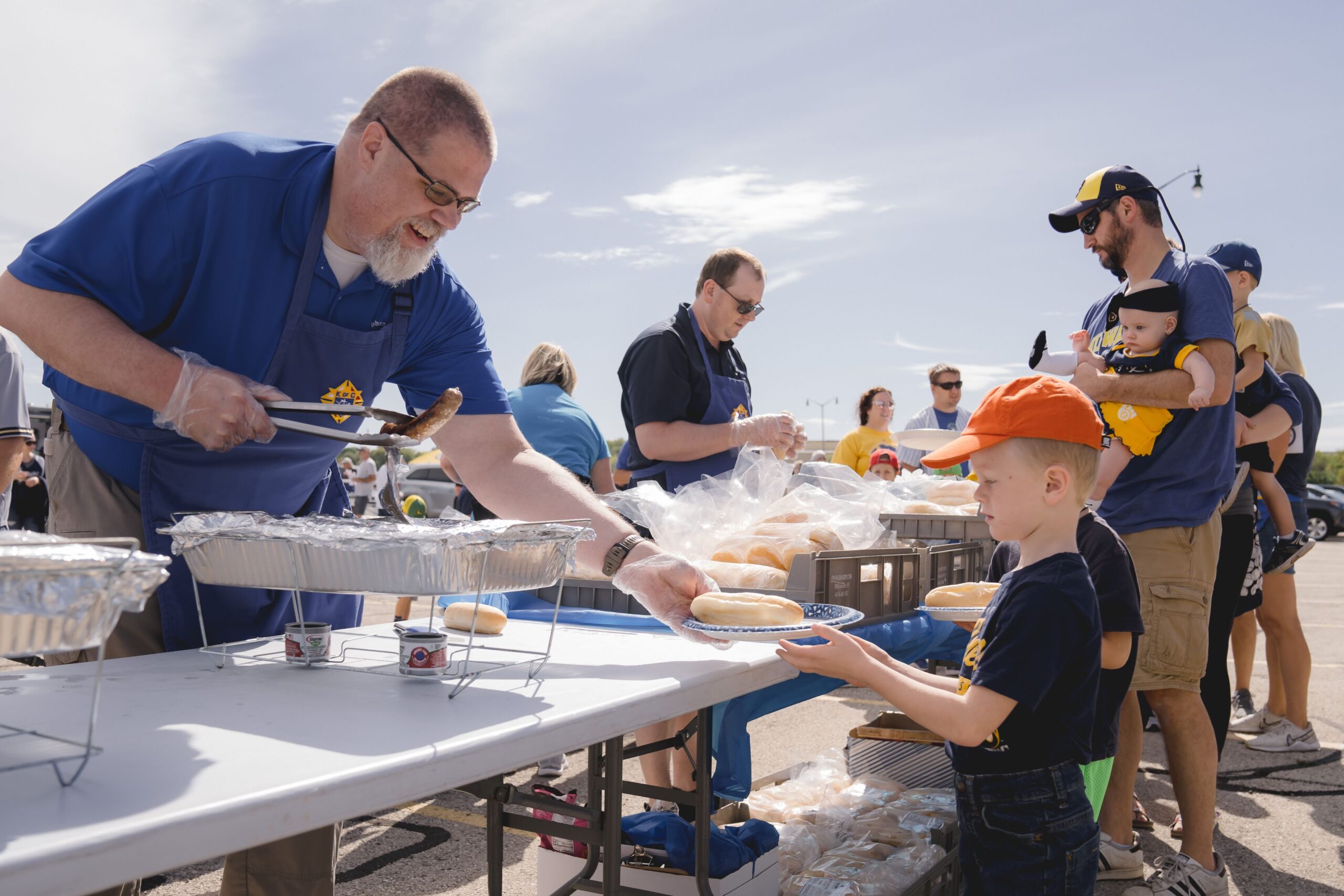
David Klamik volunteering with brother knights of Council 1709 from South Milwaukee at the Ballpark Day of Faith. (Submitted photo)
Servants of the community. Defenders of the faith in the public square. “The strong right arm of the Church.”
Over the last 130 years of their existence, the Knights of Columbus have been called many things. But what do all these epithets actually mean? What is it to be a Knight in the modern Church? Who is the Knight actually called to be?
When Sir Knight Michael Tennies first joined the Knights of Columbus on his 18th birthday, he did so at the urging of his father — and he thought it was “an old man’s type of thing.”
That impression didn’t last too long.
“It became personal as soon as I started,” said Tennies. “I found purpose because of the support of these men. I thought, ‘Maybe these guys can make me who I should be: a leader.’ At 18 years old, I was thinking, ‘Boy, my generation is nothing but followers, but we need leaders in the Church.’ I thought, ‘Maybe this organization is going to make a difference for me.’”
Tennies, now 27, just served three years as the state warden for the Wisconsin Knights of Columbus. He is in his ninth year as a Knight.
So has it made a difference?
“I would say that the leadership qualities I possess today, if any, are creditable to the support network that is the Knights,” said Tennies. “I found purpose because of the support of these men.”
Fraternity is one of the Knights’ four main principles, and it’s certainly a big part of what has compelled Tennies and so many others to join their ranks.
Getting back to that question of purpose — who are the Knights of Columbus, and what is it about this organization that transformed Tennies’ life? What is it about the organization that compelled more than 300 Catholic men in the Milwaukee area to sign up in the most recent membership drive?
Speaking for himself, Tennies attributes it to the Knights’ radical, overwhelming sense of charity — which happens to be one of the group’s other four main principles.
“It’s one of the best ways that any Christian, especially in our culture, can evangelize — by giving of oneself. It’s a Gospel everyone can understand,” said Tennies. “As an order, we invite society to build off of our foundation of charity. Guys are being called to action, and they are accepting that call.”
The 67 councils in the Archdiocese of Milwaukee donated nearly $1.2 million toward different charitable organizations last year and reported 150,000 volunteer hours visiting the sick, ministering in prison, ushering at Mass, fundraising for charities, supporting Catholic schools and performing countless other services. Local councils have been involved in everything from raising money for Ukrainians impacted by the war and religious sisters who lost all their belongings in a fire (Council 973 in Kenosha) to creating paracord “combat” Rosaries for soldiers in collaboration with the National Guard (Council 524 in New Berlin). They have organized holy hours at their parishes, supported pregnancy resource centers, stocked the shelves of food kitchens and led Rosary processions. They have hosted the Silver Rose of Our Lady of Guadalupe and the Traveling Icon of St. Joseph for public devotion.
A man who wants to become a Knight of Columbus, said Tennies, must form himself into “a living Gospel” by his acts of charity.
“We have a chivalrous name for a reason,” he said.
“I see my fellow Knights as my brothers — Catholic men with a clear mission,” said Fr. James Lobacz, who is a Fourth Degree Knight and has been a member of the organization since the 1990s.
The mission itself, added Fr. Lobacz, is often “actualized” by the Knights’ sense of fraternity. The more tightly knit a network of Knights are, the more effectively they can carry out their work.
“The Knights gather to socialize around Packer games, Christmas and Easter,” said Fr. Lobacz, who is also the chaplain for the Knights of Columbus in the Archdiocese of Milwaukee. “It’s here that they discover family situations that call for prayers and often step in to help.”
He added that the Knights of Columbus have an involvement in almost every significant event in church life, from the very large ones (like John Bosco Youth Day at Holy Hill and the Men of Christ conference) to the very small ones.
“On a parish level, Knights are often the ‘go-to group’ for volunteers for just about anything,” he said. “They are often behind parish events such as potluck suppers, card parties, Sunday breakfasts and festivals.”
Membership in the Knights of Columbus is open to any Catholic man over the age of 18. To find the nearest council, visit kofc.org/join.
History of the Knights
The Knights of Columbus was founded in 1882 by Fr. Michael J. McGivney, a priest in New Haven, Connecticut. Originally formed as a mutual benefit society, its mission soon came to include charitable causes and the promotion of Catholic values. The Knights of Columbus are driven by a four-pronged mission of charity, unity, fraternity and patriotism. These virtues are the foundation for all of the Knights’ volunteer efforts on a local, national and international scale, with 2 million members in over 16,000 local councils. As one of the world’s leading international charitable organizations, Knights around the world donated approximately 48 million service hours and nearly $154 million for worthy causes in their communities in 2021.
The Knights of Columbus was brought to Wisconsin in 1902. Council 499 of Superior was the first council formed in the state, and the second, Council 524, was started in Milwaukee just seven days later. Now centered in New Berlin, it’s still going strong after 121 years.
